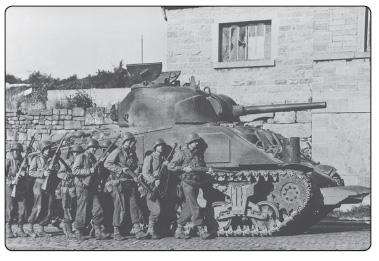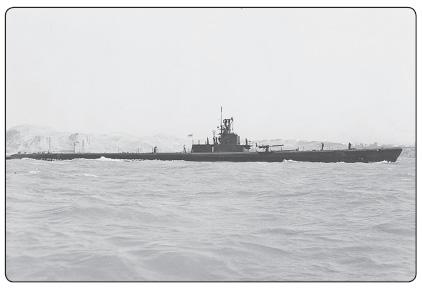The History Buff's Guide to World War II (16 page)
Read The History Buff's Guide to World War II Online
Authors: Thomas R. Flagel


U.S. infantry huddles close to an M-4 Sherman medium tank during the September 1944 advance into Belgium.
The most effective tanks were the mediums, such as the M-4 Sherman. The Sherman’s strength came from reliability and huge numbers. Eleven different companies produced more than forty thousand of them. Drawbacks included thin armor and precarious ammunition storage. A German observed that a Sherman would “burn like twenty haystacks.”
19
Workhorses of the German stable were the Panzer III and IV, which functioned exceptionally well until they encountered the Soviet T-34. With sloping armor, wide treads, and high-torque diesel engines, T-34s could punch holes in the panzers from almost a mile away. Most of all, more than sixty-four thousand were made, more than all German tanks combined. Of its shortcomings, it had no radio, which forced commanders to use flags or hand signals or play “follow the leader.”
More than anything else, superior numbers ensured Allied dominance. From 1939 to 1944, for every tank the Axis built, the Allies made eight.
20
Sometimes it took very little to knock out a tank. When a panzer division on the eastern front came under attack, more than two-thirds of the vehicles would not start. Later inspection revealed that throngs of mice had gotten into the engine compartments, probably for warmth, and chewed through the electrical wires.
6
. MEDIUM AND HEAVY BOMBERS (170,000)
Most bombers throughout the war had one or two engines, with the medium twin-engines being the mainstay of most air forces. Only the United States and Great Britain produced operational four-engine aircraft in quantity.
Japan had three medium bombers as its workhorses, all manufactured by Mitsubishi. Germany’s twin-engine Heinkel 111 was as good on paper as the U.S. B-17. Italy’s Fiat BR20M could fly nearly as far and as fast as the B-25 Mitchell. Although the Axis suffered from want of payload on their missions, failure came down to lack of protection. The Axis simply did not have the fighter escort capability of the Allies and suffered accordingly. As an example, the B-17G bristled with thirteen machine guns (hence the name “Flying Fortress”), but it still underwent terrible losses when traveling beyond fighter protection.
There were alternatives. Britain’s twin-engine De Havilland “Mosquito,” of which more than seven thousand were made, consisted of a wood frame and no defensive weapons, yet it had one of the lowest fatality rates of the RAF. Flying at around four hundred mph, Mosquitoes simply outran the competition. The famed B-29 Superfortress, a technological marvel of pressurized cabins and a range of four thousand miles, flew too high for interceptors or antiaircraft fire to reach.
On reputation, the B-17 and B-29 get accolades, but the B-24 Liberator was the most utilized and produced bomber of the war. Ugly as sin, with a fat fuselage, pug nose, and a tail fin that looked like earmuffs on a harmonica, the B-24 worked in all theaters and carried a greater load and flew farther than the B-17. It was also vastly more adaptable than the B-29. More than eighteen thousand were made, outnumbering B-17s and B-29s put together.
21

Ugly but effective, more B-24 Liberators were manufactured than any other warplane in U.S. military history.
During the war, the versatile B-24 saw service with the U.S. Army Air Force, Navy, and Marines, plus the air forces of Australia, Brazil, Canada, Nationalist China, France, Great Britain, India, liberated Italy, New Zealand, Portugal, South Africa, the Soviet Union, and Turkey.
7
. SUBMARINES (2,100)
At the start of the war, no fewer than ten navies possessed submarines. In fact, the largest underwater fleets belonged to the Soviet Union, Italy, and France.
Types were of the extreme. Smallest were “midgets,” with crews of one to five. Both the attack on Pearl Harbor and the D-day landings began with midget-sub reconnaissance. Largest was the I-400 class developed by Japan. Longer than a football field, the I-400s were intended to attack the United States and the Panama Canal but never became fully operational. The prize for endurance went to Germany’s Type IXD Ucruiser, capable of sailing around the world, whereas Japan’s manned suicide torpedo was designed for much shorter trips. For maximum flexibility, several countries had models that carried floatplanes or collapsible aircraft.
Crews commonly engaged in nonconfrontational pursuits. The low-profile vehicles were ideal for guerrilla and secret operations support, smuggling agents and ammunition as well as money and medicine. Subs also performed a large number of rescue operations. In September 1944, the USS
Narwahl
made an impressive haul by evacuating eighty-two Allied POWs from the Philippine island of Mindanao.
22

Attack sub USS
Wahoo
claimed twenty kills in the Pacific before she and her entire crew were lost off the coast of Japan in October 1943.
The most common task was hunting merchant ships. The Royal Navy eventually ruled the Mediterranean, choking off supplies to the Afrika Korps. A few hundred German U-boats, operating from the Arctic to the Caribbean, sank nearly two thousand Allied transports. After replacing defective torpedoes in 1943 (initial models swam too deep), one hundred U.S. submarines accounted for more than half of all Japanese ships sunk in the Pacific, including four thousand merchant vessels. In contrast, the Japanese mainly used their small fleet to hunt enemy warships, with costly results. On average, for every enemy vessel sunk, Japan lost one submarine.
23
The work was perilous. One in four Allied and three of four Axis submariners did not survive.
In September 1944 a TBM Avenger was shot down off the coast of Okinawa. The submarine USS
Finback
sailed to the site and managed to save the sole survivor of the three-man crew, U.S. Navy pilot Lt. George Herbert Walker Bush.
8
. DESTROYERS AND CRUISERS (1,700)
A basic measurement of a warship was its main guns. Destroyers had gun barrels of three to six inches in diameter, cruisers five to eight, battleships fourteen to eighteen. During the war, only seven navies possessed battleships, whereas eighteen owned destroyers and cruisers.
Destroyers proved to be the most adaptable of naval vessels. Used mainly to escort merchant and warship convoys, destroyers were simultaneously torpedo boats, sub hunters, rescue ships, scouts, and antiaircraft screens. They also functioned as minesweepers, coastal patrol boats, radar platforms, and support batteries for amphibious landings. The Japanese, with the third-largest contingent of destroyers, used them aggressively in surface battles and paid dearly. The Imperial Navy lost more than three hundred during the war, more than all other Japanese warship losses put together. Britain owned the second-largest fleet, using the vessels predominantly in escort duties and losing almost half as many as the Japanese, mostly to U-boats. The U.S. Navy had the largest collection of destroyers, losing eighty-two, but dominating both the Atlantic and Pacific with superior numbers and radar-sonar capability.
24
Cruisers were designed to be self-sufficient, long-distance combat ships and convoy raiders, ranging in size from very large destroyers with crews of six hundred to virtual battleships with twelve hundred officers and men. As with destroyers, the United States had the largest fleet, and the Japanese suffered the highest losses. Serving in all naval theaters, cruisers figured predominantly in the Pacific, where they proved faster than battleships and more powerful than destroyers.
25

The Japanese destroyer
Amagiri
became infamous after ramming and sinking a PT boat skippered by future U.S. president John F. Kennedy.
Days after safely delivering components of the Hiroshima bomb to Tinian Island, the cruiser USS
Indianapolis
was sunk by a Japanese sub. Out of 1,196 men on board, 900 were alive when the ship went under. Four days later 317 were rescued. The rest died of exposure, wounds, and shark attacks.
9
. AIRCRAFT CARRIERS (180)
Only Great Britain, Japan, and the United States deployed operational carriers, ranging from “escort carriers” holding a few dozen planes to “light carriers” with thirty to forty aircraft to “fleet carriers” with sixty to ninety fighters, dive bombers, and torpedo planes.
Most were escorts tasked with shepherding convoys to safety. The United States and Britain made many (110) and Japan few (5). The Japanese Empire consequently lost nearly all its merchant shipping in a few short years.
Of the light and fleet carriers, numbers were initially small. In 1940 there were nineteen large carriers in existence. By the end of 1942 thirteen of them were at the bottom of the ocean. Britain and Japan replaced their losses slowly, launching a few flattops each year, while the industrial behemoth United States almost made it look easy, commissioning fifteen new ships in 1943 alone.
26
The hull sizes of most flattops were equivalent to a cruiser. In fact, many carriers were converted from old or half-built cruisers, including the Coral Sea casualty
Lexington
, P
EARL
H
ARBOR
and Midway veteran
Akagi
, and all nine ships of the Independence class.
27
For the Royal Navy, objectives included patrolling the home islands, supporting convoys in the North Atlantic and Indian Oceans, and flushing the Italians from the Mediterranean. The U.S. and Japanese large carriers were essentially committed to attacking each other, either ship-to-ship or ship-to-shore. The battle of M
IDWAY
helped tip the scales in favor of the Americans, with the battles around L
EYTE
G
ULE
dooming the Imperial Navy for good.